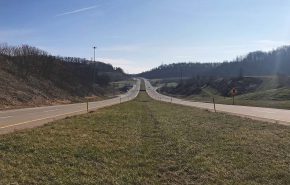Greg Nettuno, PE, Senior Vice President and Infrastructure Business Unit Director of GAI, joins us again as a guest blogger to talk about the details and effects of Pennsylvania’s transportation funding law.
In my previous blog, I touched on House Bill 1060 (or Act 89), which will generate $2.3 billion a year in Pennsylvania’s transportation funding—an increase of about 40 percent from the $5.3 billion that the Pennsylvania Department of Transportation (PennDOT) spent last year on bridges, highways, and public transit.
The industry is already seeing the effects of this new piece of legislation: the opportunity for transportation work is increasing and PennDOT is advertising significantly more projects this year. Let’s look in detail at House Bill 1060—where the additional funding is coming from, how it will be distributed, and what it will do for Pennsylvania.
Where is PennDOT getting the additional money and how will they allocate it?
Assuming a typical driver owns one vehicle, drives it 12,000 miles a year, and gets 24 miles per gallon, the individual can expect to pay $22 more a year in 2014 ($.42/week) and $132 more ($2.54/week) by 2018 due to a variety of measures phased in over five years. Some of the most significant actions to generate funding are listed below:
- Changes to state fuel tax calculations will account for 82% of the money.
- Changes/increases to vehicle registration fees from 2014 to 2017-18 (from $36 to $38 for basic passenger cars; $58.50 to $62 for pickup trucks; $18 to $20 for motorcycles; plus further increases for all classes of commercial and non-commercial trucks).
- Changes/increases to driver licensing fees from 2014 to 2017-18 (from $21 to $23, with an inflationary increase every two years thereafter).
- Changes/increases to traffic violation fines, surcharges and permits. For example, a 50% increase on certain serious moving traffic violations, which will generate an additional $86M annually by 2018, or a flat $150 fine for failure to obey traffic control devices, which will generate an additional $40M annually.
- Creation of a one-of-a-kind $144M-per-year multimodal fund by 2017-18 (funding is redirected from other sources).
These additional fees will bring significant revenue to build Pennsylvania’s infrastructure system. Check out the total annual investment from House Bill 1060 over the course of five years and how it will be allocated:
|
Transportation Asset |
Year 1 (2014) |
Year 5 Estimate |
| State Roads and Bridges |
$600 million |
$1.3 billion |
| Public Transportation |
$207 million |
$480 – $495 million |
| Local Roads and Bridges |
$37 million |
$237 million |
| PA Turnpike Expansion Projects |
$27 million |
$86 million |
| Multimodal Fund |
$60 million |
$144 million |
| Dirt/Gravel/Low-Volume Roads |
$15 million |
$30 million |
|
Total |
$946 million |
$2.3 billion – $2.4 billion |
How will this investment benefit Pennsylvania?
- Generate 18,000 jobs in 2014.
- Create 50,000 new jobs and preserve 12,000 additional jobs by its fifth year.
- Improve or rebuild 7,000 bridges and more than 10,000 miles of roadway.
- Keep Pennsylvania economically competitive with neighboring states.
- Avoid service cuts to public transportation and preserve access for users who depend on those services.
We are already seeing many Pennsylvania transportation projects come to fruition in 2014 as a direct result of Act 89, including the Birmingham Bridge Rehabilitation in Pittsburgh ($40M est.) and the Route 50 Roadway Reconstruction in South Fayette Township ($15.1M est.). Other projects include the Old Betzwood Trail Bridge Construction in Montgomery County ($9.3M), the Philadelphia Museum of Art Roadway Improvement ($8.5M), the I-95/PA Turnpike Interchange in Bucks County ($140M est.), along with many more.
This infusion of money into the state’s transportation program and the acceleration in schedules for bridge and highway projects will undoubtedly mean more orange barrels for residents of Pennsylvania. But the end result—smoother roads, safer and fewer weight-restricted bridges, improved public transportation, and easier travel—will enhance public safety while bolstering the state’s economy. Visit PennDOT for further details on Act 89 and a complete list of 2014 Act 89-funded projects by District.
Greg Nettuno, PE can be reached at 904.363.1110.


